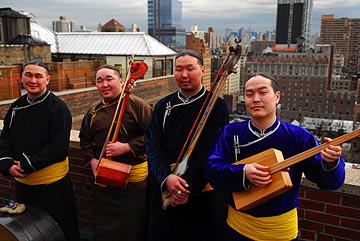Jump to:
1. From the Lungs of Central Asia
2. Between Political and Folk Narrative
3. Transcending Place
4. Music as the Frequency of Spiritual Experience
5. Continuing Exploration and Growth

Alash River, Tuva Republic. Photography by Konstantin Mikhailov
Related Links
Tuvan Musicians

– Alash Ensemble ___ Purchase
– Chirgilchin ___ Purchase
– Huun-Huur-Tu ___ Purchase
– K-Space
– Kogar-ol Ondar ___ Purchase
– Sainkho Namtchylak ___ Purchase
– Shu-De ___ Purchase
– Tyva Kyzy ___ Purchase
– Ug Shig
– Vladimir Oidupaa Oiun
– Yat-Kha ___ Purchase
Resource Sites
- – Friends of Tuva: A website with useful links, information, and article excerpts created to “commemorate Tuva’s 60th anniversary as a distinctive splotch on the world globe.”
- – Tuva Online: Tuvan news articles in English and Russian.
- – The New Research of Tuva: A quarterly journal on cultural and historical studies of Tuva.
- – Tuvan National Orchestra: Official website.
- – Overtone Music Network: Great comprehensive site that includes personal profiles of artists—including Tuvan musicians listed—and many other resources for learning.
Pop Culture
- – Sheldon’s Tuvan Throat Singing: From Big Bang Theory
- – Genghis Blues: Documentary on Paul Pena’s journey to Tuva and Kongar-ol Ondar.
- – Where Rivers and Mountains Sing by Theodore Levin and Valentine Suzukei: Sound, Music, and Nomadism in Tuva and Beyond.
- – Tuva or Bust!: Theoretical physicist Richard Feynman’s account of his determined voyage to Tuva.
- – Tuvan Trader: Buy Tuvan stuff online.
- – Siberian Shamans Come in From the Cold: Ken Hyder’s three-part report of his visit to Tuva and encounters with shamans.
- – Shamanism and Music in Siberia: Drum and Space: Ken Hyder’s essay, cited in this article.
- – Sainkho Namtchylak on Cargo Collective: Some writings and photographs by Sainkho Namtchylak that are not available on her official website.
From the Lungs of Central Asia
In the way that opera paints legends of human emotions and trials, Tuva’s palette of throat singing can vividly portray the drama of the earth. The movement of each sound and the strength with which it is delivered is often a creative interpretation of animals, elements, and landscapes, acting as a human continuation of nature.
Choduraa Tumat, of Tuva’s only all-female throat singing band, Tyva Kyzy, draws the natural parallels between throat singing and its worldly inspiration.
“Not only [in] khoomei, but some further vocal techniques of other cultures have originated in ancient times from the search and imitation by humans of the sounds of nature: the gusts of the wind, rivers, the songs of birds, the babbling of a brook,” she says. These symbolic imitations however, are not always necessary or intentional.
“Throat singing is a mimesis in the sense that the styles and sounds can be associated with a particular type of landscape [like] ‘Mountain Kargyraa’, but they are not necessarily a direct imitation of a particular sound in nature,” say members of the Alash Ensemble, an internationally-acclaimed traditional Tuvan band.
Beyond the physical imagery, there is also a much deeper connection that is directed by the passion of performers.
“For Tuvans, I would say, khoomei expresses thought within the field of sound,” Tumat explains. “And that is why, for the majority of Tuvans — even those who do not sing but only listen — it evokes associations with the sounds of nature, while for the performers, as they sing, it would be native lands, mountains, steppe, taiga, and so on.”
While Tuvan throat singing was traditionally performed solo and often in pastoral settings, contemporary performance has evolved to emphasize bands, audiences, and a stage.
“I think that in the present time, the power and technique of a performer relies on how much they can control their emotions and nerves while performing in a new context, on a stage in front of other people and not in nature, not for one’s self or for close ones,” Tumat says, pointing out the challenges of stage performance. “In order to overcome my nerves during performance, I, and maybe even other performers, visualize nature [and] listen to my own voice, painting in my mind the mountains and steppe. And it is because of this that sadness, nostalgia, pride, and joy are all present in song.”
[audio:/wp-content/uploads/2013/05/Tuvan_1_Chirgilchin_Konturei.mp3|titles=Chirgilchin – Konturei]
Tyva Kyzy – “Sit and Be Amazed”
[audio:/wp-content/uploads/2013/05/Tuvan_2_Tyva-Kyzy_Sit-and-Be-Amazed.mp3|titles=Tyva Kyzy – Sit and Be Amazed]
Kongar-ol Ondar & Paul Pena – “Eki A’ttar” (“Good Horses”)
[audio:/wp-content/uploads/2013/05/Tuvan_3_Eki-A-Ttar_Good-Horses.mp3|titles=Kongar-ol Ondar and Paul Pena – Eki A’ttar (Good Horses)]
Oidupaa Vladimir Oiun – “There Are Many Tears Here Gained”
[audio:/wp-content/uploads/2013/05/Tuvan_4_Oidupaa-Vladimir-Oiun_There-Are-Many-Tears-Here-Gained.mp3|titles=Oidupaa Vladimir Oiun – There Are Many Tears Here Gained]
Styles & Techniques of Tuvan Throatsinging 1
A talented throat singer may incorporate numerous styles, cascading from the Sygyt songbird warble to the hollow echo of Khoomei and the mesmerizing waterfalls of Borbangnadyr. Though Tuva is far from any of our planet’s oceans, the deep gnostic growl of Kargyraa resonates with an oceanic weight, as though each breath were pulled from the deepest trenches of our planet. Extreme emotional responses can be triggered by a gifted performer, and even those sounds that are unpleasant or even frightening to a Western aesthetic have their own significant powers.
Khoomei – Хөөмей
The term khoomei is often used in Tuvan and Russian to describe throat-singing in general, but it also refers to a specific style. Khoomei is performed in the mid-range, and because of its sometimes hollow sound, it can evoke wind or movement.
Sygyt – Cыгыт
Sygyt is a high-range style of throat-singing, which may sometimes be referred to as the “Clear Sound”. It is a great challenge to perform sygyt without producing undesirable lower harmonics.
Kargyraa – Каргыраа
The powerful and intense style of kargyraa is identified by its low range. Comparison can be drawn with the chanting of Tibetan monks. Vowels form the foundation for kargyraa song, and because of its depth and fullness, this style can have immense effects on a listener.
Borbangnadyr – Борбангнадир
Borbangnadyr, more of an effect than a separate style, is easily recognized for its gurgling effect, where sound ripples like water. The natural association is obvious and can be heard generally in mid- to high- ranges. Sygyt sung with a borbangnadyr effect can very easily sound like a bird call.
Footnotes ___ Back to Top
1 “About Tuvan Throat Singing”, Alash Ensemble. Retrieved 2013-04-16.







Very educating!
Thank you for information!
I will wait for more to come from this author.
[…] Tuva’s Meridian of Musicality, Spirituality, and Cross-Cultural Place: A Primer On Tuvan Throat Singing: http://www.redefinemag.com/2013/tuvan-throat-singing-musicality-spirituality-cross-cultural-place/ […]
[…] http://www.redefinemag.com/2013/tuvan-throat-singing-musicality-spirituality-cross-cultural-place/3/ […]
[…] TUVA’S MERIDIAN OF MUSICALITY, SPIRITUALITY AND CROSS-CULTURAL PLACE: A PRIMER ON TUVAN THROAT SINGING // http://www.redefinemag.com/2013/tuvan-throat-singing-musicality-spirituality-cross-cultural-place/ […]